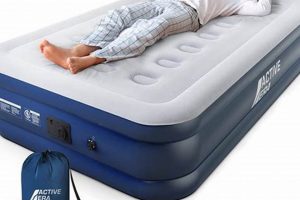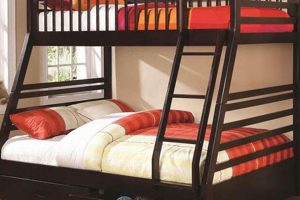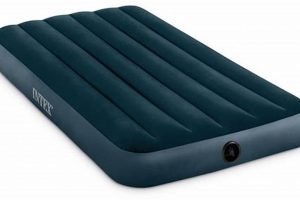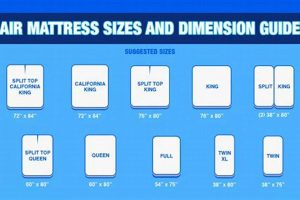A sleeping platform designed for use within recreational vehicles, offering a compact and comfortable rest area, often measures approximately 38 inches wide and 75 inches long. Such a platform provides an individualized sleeping space within the constrained dimensions typical of RVs.
The utilization of these specialized sleeping platforms maximizes available space within a camper, allowing for improved mobility and storage. The benefits include weight management and suitability for single sleepers, addressing the need for efficient space utilization and personalized comfort. Historically, such designs evolved from basic camping cots to integrated components of contemporary RV layouts, reflecting a growing demand for compact and functional accommodations.
The following discussion will address key considerations for selecting an appropriate sleeping platform for a camper, including material composition, thickness, support structure, and relevant environmental factors such as temperature and humidity resistance, along with strategies for proper care and maintenance to ensure longevity and optimal performance.
Selection and Maintenance Tips
Proper selection and maintenance are paramount to optimizing the lifespan and comfort of a camper sleeping platform. The following tips provide guidance in these areas.
Tip 1: Material Selection. Prioritize materials offering a balance of comfort, durability, and weight. High-density foam or hybrid constructions offer support and resilience, while remaining lightweight to minimize fuel consumption.
Tip 2: Measure Available Space. Accurately measure the intended location within the camper. Account for wheel wells, cabinet protrusions, and other obstructions to ensure a proper fit and prevent unnecessary compression or damage.
Tip 3: Evaluate Thickness and Support. The ideal thickness provides adequate support for the intended sleepers weight and preferred sleeping position. Insufficient thickness can lead to discomfort and premature wear, while excessive thickness may compromise headroom and storage space.
Tip 4: Consider Cover Material. Opt for covers constructed from breathable, moisture-wicking materials. This helps regulate temperature, reduce the risk of mold or mildew growth, and improve overall hygiene.
Tip 5: Ventilation and Moisture Control. Ensure adequate ventilation around the sleeping platform. Employ moisture-absorbing materials or dehumidifiers within the camper to prevent moisture buildup and extend the lifespan of the platform.
Tip 6: Regular Cleaning and Rotation. Periodically clean the cover according to manufacturer instructions. Rotate the sleeping platform regularly to distribute wear and prevent sagging in specific areas.
Tip 7: Invest in a Protective Cover. When not in use, protect the sleeping platform with a cover to shield it from dust, sunlight, and potential damage during storage or transport.
Applying these tips will enhance the comfort, durability, and longevity of a camper sleeping platform, contributing to a more enjoyable and restful travel experience.
The concluding section will summarize the key considerations outlined in this article, emphasizing the importance of informed decision-making when selecting and maintaining a sleeping platform for use within a camper.
1. Dimensions and Fit
The correlation between a sleeping platform’s dimensions and the spatial constraints of a camper interior dictates functionality and comfort. Precise measurements and appropriate fitting are paramount for optimal use of available space and ensuring unhindered movement within the vehicle.
- Accurate Measurement of Available Space
Prior to selection, detailed measurement of the designated sleeping area within the camper is essential. This includes accounting for wheel wells, cabinetry, and any other structural elements that may encroach upon the available space. Inaccurate measurements can result in a purchase that is unusable or requires modification, leading to unnecessary expense and inconvenience. Example: A twin sized platform measuring slightly over the allotted 75 inches in length might necessitate alterations to the camper’s interior or result in an obstructed pathway.
- Standard vs. Custom Dimensions
Standard “twin mattress for camper” sizes are readily available, often conforming to approximately 38 inches by 75 inches. However, certain camper configurations may necessitate custom dimensions. The selection between standard and custom sizes hinges upon the degree of deviation from conventional RV layouts. Example: A vintage camper with unique interior dimensions might require a custom-sized sleeping platform to maximize space utilization.
- Edge Support Considerations
Edge support pertains to the structural integrity along the perimeter of the sleeping surface. Sufficient edge support prevents premature sagging and ensures consistent comfort across the entire surface. Inadequate edge support can result in a diminished sleeping area and an increased likelihood of rolling off the platform. Example: A poorly constructed platform lacking reinforced edges may exhibit significant compression along its borders after prolonged use, creating an uneven sleeping surface.
- Compatibility with Camper Layout
The dimensions must align with the overall layout of the camper, allowing for ease of access to storage compartments, seating areas, and other essential features. A poorly fitting platform can impede movement, obstruct storage access, and compromise the functionality of the camper’s design. Example: An excessively wide sleeping platform may block access to under-bed storage or restrict the maneuverability of swivel chairs.
The interplay between dimensions, fit, and the specific characteristics of the camper underscores the importance of meticulous assessment. A sleeping platform optimized for dimensions and fit ensures comfort, maximizes space, and contributes to the overall functionality of the recreational vehicle, in relation to the “twin mattress for camper” needs.
2. Material and Construction
The functional efficacy and longevity of a “twin mattress for camper” are inextricably linked to the materials used in its construction and the methods employed in assembling these components. Material selection directly influences comfort, support, insulation, and resistance to environmental factors such as moisture and temperature fluctuations, commonly encountered within the confines of a recreational vehicle. Inferior materials or substandard construction techniques compromise these attributes, resulting in diminished user satisfaction and premature product failure. Example: A platform utilizing low-density foam will exhibit reduced support and a shorte
r lifespan compared to one constructed with high-density memory foam or a hybrid innerspring system.
Construction methods, including the type of stitching, bonding agents, and internal support structures, play a crucial role in maintaining the integrity and dimensional stability of the sleeping surface. Poorly executed seams can lead to tearing or separation, while inadequate internal support can result in sagging and uneven weight distribution. Furthermore, the outer cover material must provide adequate protection against abrasion, staining, and moisture penetration, contributing to both the aesthetic appeal and functional resilience of the unit. Example: A cover constructed from a tightly woven, water-resistant fabric will offer superior protection compared to a loosely woven, non-treated material. Similarly, reinforced seams and edges will enhance durability and prevent fraying.
In summary, the selection of appropriate materials and adherence to rigorous construction standards are paramount for ensuring the performance, durability, and overall value of a “twin mattress for camper.” Compromises in these areas invariably lead to reduced comfort, diminished lifespan, and increased replacement costs. A thorough understanding of material properties and construction techniques is essential for making informed purchasing decisions and optimizing the investment in a reliable and comfortable sleeping solution.
3. Weight and Portability
Weight and portability are critical determinants of suitability for a sleeping platform intended for recreational vehicle use. The mass of the “twin mattress for camper” directly impacts fuel efficiency, ease of installation/removal, and storage considerations within the limited confines of the vehicle. A heavier platform adds to the overall vehicle weight, increasing fuel consumption and potentially reducing payload capacity. Cumbersome platforms further complicate setup and storage, negatively affecting the user experience.
- Impact on Fuel Efficiency
Excess weight directly correlates with increased fuel consumption. Every additional pound adds to the burden on the vehicle’s engine, resulting in lower miles per gallon. The cumulative effect of a heavy sleeping platform, coupled with other onboard equipment, can significantly reduce fuel economy, especially during long-distance travel. Example: A 50-pound sleeping platform contributes less to fuel inefficiency than an 80-pound model, particularly on inclined terrains.
- Ease of Installation and Removal
The weight of the sleeping platform influences the ease with which it can be installed, removed, and repositioned within the camper. A lighter platform simplifies these tasks, reducing physical strain and enabling quicker setup and takedown. Heavier platforms may require two individuals for safe handling, increasing complexity. Example: A lightweight, foldable design can be easily managed by a single person, whereas a heavy, non-foldable platform may necessitate assistance and specialized equipment for maneuvering.
- Storage Considerations
When not in use, the sleeping platform requires storage within the camper or externally. A lighter, more compact platform occupies less storage space, freeing up valuable room for other essential items. Conversely, a bulky platform can consume a significant portion of the available storage, potentially necessitating external storage solutions. Example: A foldable, lightweight platform can be stowed in a smaller compartment compared to a rigid, heavy model.
- Material Composition and Weight Trade-offs
The materials used in the sleeping platform’s construction influence its weight and performance characteristics. Lightweight materials, such as open-cell foam or lightweight alloys in support structures, can reduce the overall mass but may compromise durability or support. Conversely, heavier materials, such as high-density memory foam or solid wood frames, offer enhanced support and longevity but add to the platform’s weight. Example: Balancing weight reduction with durability requires selecting appropriate materials based on anticipated usage and load requirements.
Optimizing weight and portability of the “twin mattress for camper” requires careful consideration of these factors. A lightweight, easily manageable platform enhances fuel efficiency, simplifies setup, and maximizes storage space, contributing to a more enjoyable and practical recreational vehicle experience. Selecting the right balance between weight, durability, and comfort is essential for optimizing user satisfaction.
4. Support and Comfort
The characteristics of support and comfort are intrinsically linked to the efficacy of a “twin mattress for camper,” influencing sleep quality and overall user satisfaction within the constrained environment of a recreational vehicle. Adequate support ensures proper spinal alignment, mitigating discomfort and preventing potential musculoskeletal issues. Concurrently, comfort enhances the sleep experience, fostering relaxation and contributing to restorative rest. The interplay between these elements is crucial for optimizing the functionality of a sleeping platform in mobile living scenarios.
- Core Material Density and Distribution
The density and distribution of the core material, typically foam or innerspring components, directly affect the support characteristics of the platform. Higher density materials offer greater resistance to compression, providing enhanced support for heavier individuals and preventing sagging over time. Uneven distribution of material can create pressure points, compromising comfort and potentially leading to discomfort. Example: A memory foam core with varying density zones can conform to the body’s contours while providing targeted support to the lumbar region, addressing both comfort and spinal alignment.
- Surface Layer Composition and Texture
The composition and texture of the surface layer significantly influence the tactile comfort of the platform. Materials such as quilted fabrics or plush foam layers provide a cushioning effect, enhancing the initial sensation of comfort upon contact. Breathability is also a critical factor, as it facilitates air circulation and prevents overheating, contributing to a more comfortable sleep environment. Example: A surface layer composed of breathable bamboo fabric can wick away moisture and promote airflow, reducing the likelihood of night sweats and enhancing overall comfort.
- Weight Distribution and Pressure Relief
Effective weight distribution and pressure relief are essential for minimizing discomfort and promoting restful sleep. A platform that evenly distributes weight reduces pressure points on the hips, shoulders, and other sensitive areas, preventing pain and discomfort. Conversely, localized pressure points can disrupt sleep and contribute to tossing and turning. Example: A platform incorporating a layer of gel-infused memory foam can conform to the body’s shape and distribute weight evenly, minimizing pressure points and promoting a more comfortable sleep experience.
- Edge Support and Stability
Edge support contributes to the overall stability and usability of the platform, particularly for individuals who tend to sleep near the edge. Adequate edge support prevents saggin
g and ensures a consistent level of comfort across the entire sleeping surface. Insufficient edge support can create a sensation of instability and increase the risk of rolling off the platform. Example: Reinforced edges constructed from high-density foam or steel springs can provide enhanced edge support, ensuring a stable and comfortable sleeping surface across the entire platform.
The aforementioned factors collectively determine the degree to which a “twin mattress for camper” effectively delivers both support and comfort. Careful consideration of these elements is essential for selecting a platform that promotes restful sleep and enhances the overall recreational vehicle experience. The synergy between supportive infrastructure and comfort-enhancing surface materials dictates the long-term viability and user satisfaction of a camper sleeping platform.
5. Durability and Lifespan
The functional lifespan of a “twin mattress for camper” is directly proportional to the materials utilized in its construction and the rigor of its manufacturing processes. A durable sleeping platform designed for recreational vehicle use must withstand the rigors of travel, including vibrations, temperature fluctuations, and potential exposure to moisture. Premature degradation of materials or structural failure compromises the comfort and usability of the platform, necessitating costly replacements and disrupting the travel experience. For example, a low-density foam mattress may quickly compress under repeated use, resulting in diminished support and an uneven sleeping surface. Conversely, a platform incorporating high-density foam or innerspring components, combined with a reinforced frame, is better equipped to maintain its shape and structural integrity over extended periods.
The environmental conditions within a camper also contribute significantly to the durability of the sleeping platform. Elevated humidity levels promote the growth of mold and mildew, which can degrade the internal structure and compromise the hygienic properties of the mattress. Frequent temperature fluctuations can cause materials to expand and contract, leading to cracking, warping, or delamination. Furthermore, exposure to direct sunlight can fade or damage the outer cover, reducing its protective capabilities and aesthetic appeal. To mitigate these effects, the selection of moisture-resistant materials, UV-protective coatings, and proper ventilation are crucial. Practical applications include the use of breathable mattress covers, dehumidifiers within the camper, and protective storage measures when the vehicle is not in use.
In summary, the durability and lifespan of a “twin mattress for camper” are determined by a combination of material quality, construction techniques, and environmental factors. Selecting a platform constructed from robust materials, employing effective protective measures, and implementing proper maintenance practices will maximize its longevity and ensure continued comfort throughout the vehicle’s service life. Investing in a durable and well-maintained sleeping platform is a prudent decision that enhances the overall recreational vehicle experience and minimizes long-term costs.
Frequently Asked Questions
The subsequent questions and answers address common inquiries concerning sleeping platforms for recreational vehicles, designed to clarify specifications and proper use.
Question 1: What are the standard dimensions for a twin sleeping platform intended for camper use?
The typical dimensions approximate 38 inches in width and 75 inches in length. However, variations may occur based on specific camper models and layouts. Pre-purchase measurement of the designated area is essential.
Question 2: What material characteristics should be considered for optimal comfort and durability?
High-density foam, memory foam, or hybrid innerspring systems are recommended. These materials offer a balance between support, weight management, and longevity. The cover material should be breathable and moisture-resistant.
Question 3: How does the weight of the sleeping platform impact fuel efficiency in a recreational vehicle?
Increased weight contributes to diminished fuel efficiency. Selecting a lightweight yet durable model minimizes the burden on the vehicle’s engine, thereby reducing fuel consumption.
Question 4: What are the recommended maintenance procedures for extending the lifespan of the twin sleeping platform?
Regular cleaning of the cover, periodic rotation of the platform, and the use of a protective cover during storage are advised. Ventilation within the camper also minimizes moisture buildup and prolongs the platform’s usability.
Question 5: How should moisture accumulation be managed to prevent mold and mildew growth?
Ensure adequate ventilation within the camper. Employ moisture-absorbing materials or a dehumidifier to maintain a dry environment. Regularly inspect the platform for signs of moisture damage.
Question 6: Is customization of sleeping platform dimensions a viable option for uniquely configured campers?
Customization is feasible and often necessary for accommodating non-standard camper layouts. Accurate measurements and consultations with specialized manufacturers are crucial for ensuring a proper fit.
The preceding responses provide fundamental insights into selecting, maintaining, and optimizing the use of a “twin mattress for camper.” Attention to these details enhances the comfort and longevity of this essential component.
The following article section will summarize the key considerations presented, reinforcing the importance of informed decision-making regarding RV sleeping arrangements.
Conclusion
The preceding discourse addressed the critical considerations associated with selecting and maintaining a “twin mattress for camper.” Dimensions, material composition, weight, support characteristics, durability, and maintenance protocols have been identified as essential determinants of suitability and longevity.
Effective implementation of the outlined recommendations ensures optimization of comfort, space utilization, and overall value. Prospective purchasers and current owners are encouraged to apply these principles to enhance the functionality and longevity of their recreational vehicle sleeping arrangements, ensuring a more comfortable and practical travel experience.


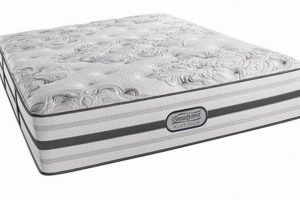
![Deals on Twin Mattress Black Friday Sale [Year] | [Brand] Organic & Natural Mattress Buyer’s Guide: Non-Toxic Sleep Solutions Deals on Twin Mattress Black Friday Sale [Year] | [Brand] | Organic & Natural Mattress Buyer’s Guide: Non-Toxic Sleep Solutions](https://mattressworldpa.com/wp-content/uploads/2025/07/th-5066-300x200.jpg)
